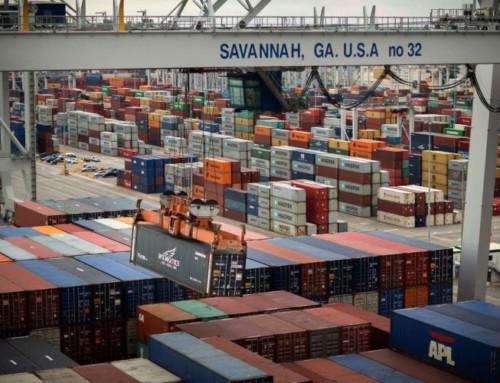This article first appeared in The Washington Post
Why it’s now cheaper to produce some goods in the South than in China
Before World War II, red-brick textile mills that processed cotton and wove it into cloth were all over the southern United States, dotting the Carolinas, Georgia and Alabama. But in the past 50 years, automation, free trade agreements and competition from countries like China whittled down the historic industry until it was almost gone.
 Now some textile jobs are coming back, but on much different terms. As the New York Times reported Sunday, some Chinese manufacturers are setting up shop in the United States, after finding it cheaper to produce their goods in the American South than in China.
Now some textile jobs are coming back, but on much different terms. As the New York Times reported Sunday, some Chinese manufacturers are setting up shop in the United States, after finding it cheaper to produce their goods in the American South than in China.
Keer Group, a Chinese yarn-maker, is investing $218 million in a factory in South Carolina. Another Chinese manufacturer, JN Fibers, is investing$45 million in the state. And Indian company called ShriVallabh Pittie is investing $70 million in a yarn-spinning plant in nearby Sylvania, Ga.
The changes are happening in other industries and locations, as well: Chinese auto glass maker Fuyao is investing in a $230 million production facility in Ohio, and Chinese acquirers are expanding manufacturing capacity at Cirrus Aviation in Minnesota and Nexteer Automotive in Michigan.
An index created by Boston Consulting shows how much the difference between the cost of manufacturing something in the United States and making the same thing in China has narrowed. In 2004, a good that could be made for a dollar in the United States could be manufactured in China for 86.5 cents. One decade later, that $1 product in the United States would cost 95.6 cents to make in China — not a whole lot of savings.
The narrowing of the gap has a little to do with what’s happening in America and more to do with what’s happening in China.
Americans are still making far more in wages than Chinese manufacturing workers. Adjusted for productivity, Chinese factory workers made $12.47 an hour last year, a little more than half of what American workers made, $22.32 an hour, according to figures from the Boston Consulting Group.
But other attributes of doing business in America make up the difference in cost. For example, state and local governments offer ample tax breaks and subsidies to companies that set up shop in their jurisdictions. America’s natural gas boom has also lowered the cost of electricity, attracting energy-intensive manufacturing industries.
Overcoming trade barriers and taking advantage of free trade agreements can also make a big difference: For example, yarn manufacturers might set up shop in the United States to take advantage of agreements with Mexico and Central America, whose factories transform the yarn into fabric and clothes that are shipped back to American consumers.
And U.S. workers are relatively educated and productive, making them especially suited to advanced manufacturing, like auto parts and consumer electronics. All in all, the United States is now one of the lowest-cost locations for manufacturing in the developed world, BCG has said.
But Thilo Haneman, a research director at Rhodium Group who studies Chinese investment in the United States, says that the return of these manufacturing jobs is not really due to changes happening in America. “I think what’s mostly being reflected is the change of commercial realities in China,” he says.
As China’s economy has developed, wages have risen, and so have the costs of land, energy and other raw materials.
The chart below, from Boston Consulting Group, shows how the competitiveness of manufacturing in China and Russia has changed over the past 10 years. Even when adjusted for productivity, Chinese manufacturing wages have risen by 187 percent over the decade. Industrial electricity costs have grown 66 percent, while natural gas costs are up 138 percent.
In the same time frame, U.S. wages have risen only 27 percent, while natural gas costs have fallen 25 percent, according to Boston Consulting.
For products where Chinese companies need access to qualified labor or proximity to American consumers, and don’t require lots of low-cost labor, it can make a lot of sense to manufacture in the United States, Haneman says.
The yarn-spinning operations are in this mold. That industry is heavily automated and doesn’t require a lot of labor. More labor-intensive work, like actually sewing garments, still relies on inexpensive workers in Bangladesh, Vietnam, Mexico and elsewhere. Those types of jobs won’t be coming back to the United States anytime soon.
And because the industries that are returning to the United States are heavily automated, they won’t provide anywhere near the number of jobs that manufacturing facilities did in past decades. The Economic Policy Institute, a left-leaning think tank, estimates that the U.S. trade deficit in goods with China eliminated or displaced 3.2 million American jobs between 2001 and 2013, three-fourths of which were in manufacturing. And that’s not to mention the millions of manufacturing jobs that were lost to automation and offshoring in the decades before that.
Chinese investment in the United States remains small, but, as the chart below by the Rhodium Group shows, it is bringing tangible economic benefits in the form of jobs.
Manufacturing in the United States may never return to the heights it reached in the 1980s, and the industries that come back onshore today are much more automated, creating fewer jobs overall. But these more skilled manufacturing jobs will still be a boon to the U.S. economy. For one, they tend to be better paid: Manufacturers these days need more highly trained workers who know how to operate automated systems.
China’s manufacturing prowess is also unlikely to disappear anytime soon. The move out of China mainly applies to new factories, rather than existing ones. Companies have invested lots of money over the past decade to build factories in China that may have life spans of 20 or 30 years, and most will likely see those investments through. And China offers manufacturers other advantages besides just price: It’s become a manufacturing hub where suppliers and consumers of all types of goods can coexist in proximity to each other, which brings down the manufacturer’s price.
But Haneman of Rhodium Group sees Chinese manufacturing investments in the United States as a great opportunity, not just for individual workers but also the U.S.-China economic relationship. In the past, Americans also benefited from trade ties with China, but in less visible ways — like having cheaper price tags on TVs and sweaters. In contrast, the negative consequence of trade with China — the migration of manufacturing jobs overseas — was far more tangible and immediate to people, says Haneman.
Now, with the rise in U.S. employment at Chinese firms, the benefits of trade with China will be a little more visible.




